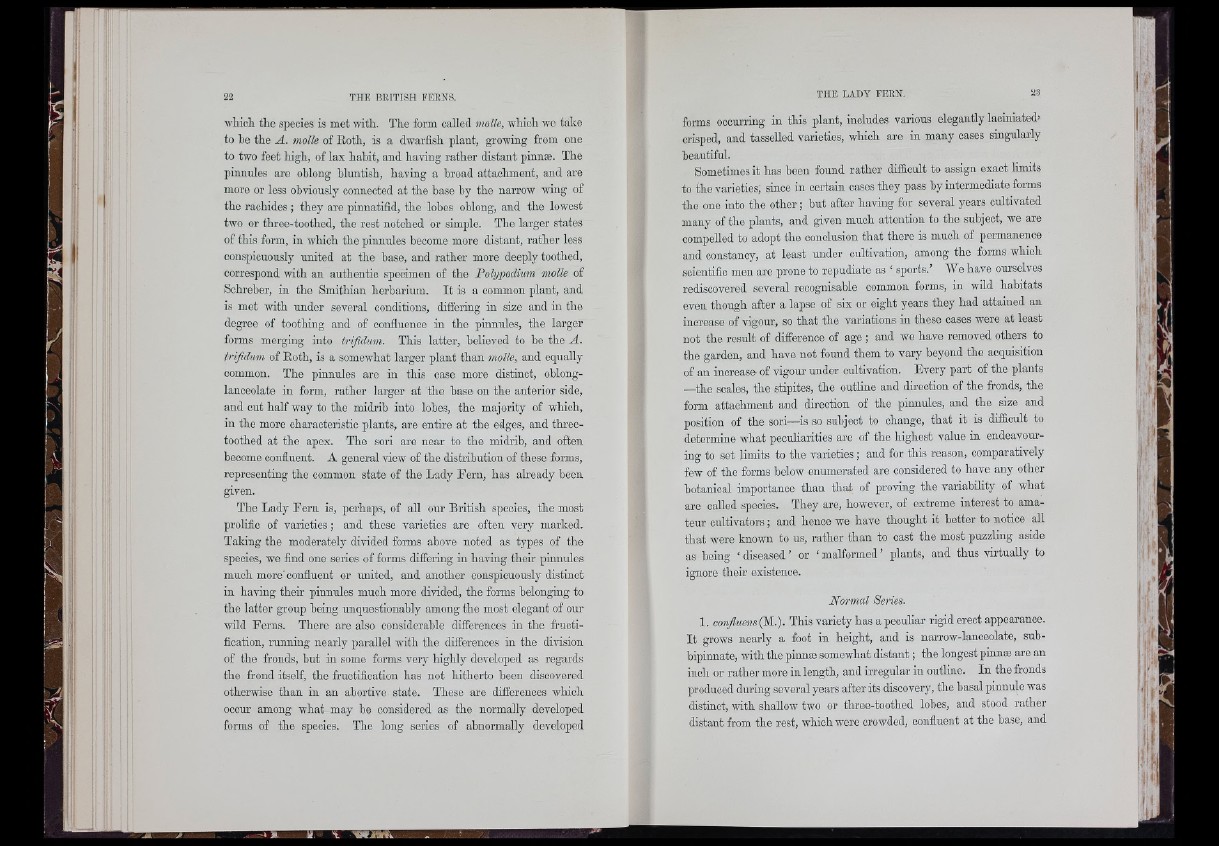
wliioli the species is met with. The form called molle, which wo take
to be the A. molle of Eoth, is a dwarfish plant, growing from one
to two feot high, of lax habit, and having rather distant pinnæ. The
pinnules are oblong bluntisb, having a broad attachment, and are
more or less obviously oonneoted at the base by the narrow wing of
the rachides ; they are pinnatifid, the lobes oblong, and the lowest
two or three-toothed, the rest notched or simple. The larger states
of this form, in which the pinnules become more distant, rather less
conspicuously united at the base, and rather more deeply toothed,
correspond with an authentic specimen of the Polypodium molle of
Sehreber, in the Smithian herbarium. It is a common plant, and
is met witb under several conditions, differing in size and in the
degree of toothing and of oonfluonoe in the pinnules, the larger
forms merging into trifidmn. This latter, believed to be the A.
trifidmn of Eoth, is a somewhat larger plant than molle, and equally
common. The pinnules are in this case more distinct, oblong-
lanceolate in form, rather larger at the base on the anterior side,
and out half way to the midrib into lobes, the majority of which,
in the more characteristic plants, are entire at the edges, and threetoothed
at the apex. The sori are near to the midrib, and often
become confluent. A general view of tbe distribution of these forms,
representing tbe common state of tbe Lady Fern, has already been
given.
The Lady Fern is, perhaps, of all our British species, the most
prolific of varieties ; and these varieties are often very marked.
Taking the moderately divided forms above noted as types of the
species, we find one series of forms differing in having their pinnules
much more' confluent or united, and another oonspionously distinct
in having their pinnules much more divided, the forms belonging to
the latter group being unquestionably among the most elegant of our
wild Ferns. There are also considerable differences in the fructification,
running nearly parallel with the differences in the division
of the fronds, but in some forms very highly developed as regards
the frond itself, the fructification has not hitherto been discovered
otherwise than in an abortive state. These are differences wbich
occur among what may be considered as the normally developed
forms of the species. The long series of abnormally developed
forms ocom-ring in this plant, includes various elegantly laoiniated’
crisped, and tasseUed varieties, which are in many cases singularly
beautiful.
Sometimes it has been found rather difficult to assign exact limits
to the varieties, since in certain cases they pass by intermediate forms
the one into the other ; but after having for several years cultivated
many of the plants, and given much attention to the subject, we are
compelled to adopt the conclusion that there is much of permanence
and constancy, at least under cultivation, among the forms which
scientific men arc prone to repudiate as ‘ sports.’ We have ourselves
rediscovered several recognisable common forms, in wild habitats
even though after a lapse of six or eight years they had attained an
increase of vigour, so that the variations in these cases were at least
not the result of difference of age ; and we have removed others to
the garden, and have not found them to vary beyond the acquisition
of an increase' of vigour under cultivation. Every part of the plants
—the scales, the stipites, the outline and direction of the fronds, the
foi-m attachment and direction of the pinnules, and the size and
position of the sori—^is so subject to change, that it is difficult to
determine what peculiarities are of the highest value in endeavouring
to set limits to the varieties ; and for this reason, comparatively
few of the forms below enumerated are considered to bave any other
botanical importance than that of proving the variability of what
are called species. They are, however, of extreme interest to amateur
cultivators ; and hence we have thought it better to notice all
that were known to ns, rather than to cast the most puzzling aside
as being ‘ diseased ’ or ‘ malformed ’ plants, and thus virtually to
ignore their existence.
Normal Series.
1. confluens (Ml.). This variety has a peouUar rigid erect appearance.
It grows nearly a foot in height, and is narrow-lanceolate, sub-
hipinnate, with the pinnæ somewhat distant ; the longest pinnæ are an
inch or rather more in length, and irregular in outUne. In the fronds
produced during several years after its discovery, the basal pinnule was
distinct, with shallow two or three-toothed lobes, and stood rather
distant from the rest, which were crowded, confluent at the base, and
f. ;
1